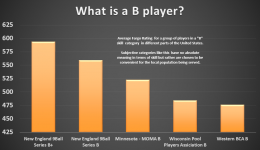All you need to do is think a bit, taking out someone totally new to pool that is not even a D and Pro level players, you have DCBA.
D is just learning proper stance and what position even is, never mind how to play it. So starting from that, try to put in the rankings in skill level. If you go with D is new, C can run a rack, where the hell is the skill level between that, and where does that put a B or A player?
Or if you put in a B player that can run out several racks or be running out with ball in hand all the time, where does that put the A players?
This is a good description but I find that it takes out the Pro level and makes a C+ player seem better than they are, does not leave a lot of room for variance, again taking the C and B players too a too high skill rating and the A players are going up to near Pro levels. Does not leave room for players, we go from D a beginner to B- running out a rack easily. That is too close of a rating there, a B- would not often run out, they tend to make too many mistakes.
http://billiards.colostate.edu/threads/ratings.html#A-D
"Here's an alternative and more-detailed interpretation of the A-D scale from Capelle's "Play Your Best Pool" (p.386):
D: A beginner or someone who plays so infrequently that their game remains in the beginner category.
C-: A below average player - this denotes a player with some recognizable skills who has definitely risen from the ranks of beginners. This is the first major milestone.
C: An average player - describes a large section of pool enthusiasts with experience whose games perhaps have leveled off, or that only play occasionally.
C+: Above average player - this group plays a very acceptable game of pool. They tend to dominate their level of competition.
B-: This is perhaps the biggest hurdle, as a good number of players peak at the C+ level. A B- is a good player who is quite capable of running a rack of Eight Ball or Nine Ball. However, they usually lack consistency.
B: A solid, advanced player - these players can run out fairly regularly, but lack a little consistency.
B+: Players at this level are often mistaken for lower level A players when they are playing well because they play a very tough, well-rounded game. They can run out from nearly anywhere at anytime.
A-: Another big jump is required to break through to the "A" level. This group of players could be classified as semi-pros or top amateurs. They are very skilled in nearly all facets of the game. They run out easily and very often.
A: A professional quality player who can compete with and occasionally beat all but the best players. Very skilled, solid, and consistent. Runs multiple racks quite often. Tough to beat.
A+: Touring Pro - the best. Skilled in every area of the game. Breaks and runs out multiple racks regularly. Definitely in a class by themselves."
